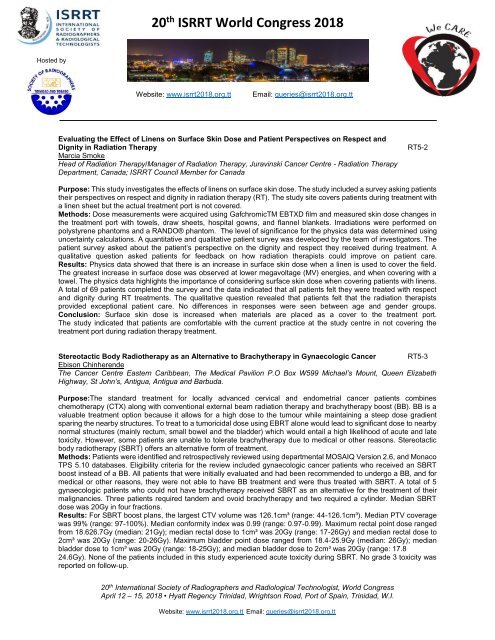Trinidad-and-Tabago-Congerss-Abstract-Book
Create successful ePaper yourself
Turn your PDF publications into a flip-book with our unique Google optimized e-Paper software.
20 th ISRRT World Congress 2018<br />
Hosted by<br />
Website: www.isrrt2018.org.tt<br />
Email: queries@isrrt2018.org.tt<br />
Evaluating the Effect of Linens on Surface Skin Dose <strong>and</strong> Patient Perspectives on Respect <strong>and</strong><br />
Dignity in Radiation Therapy<br />
Marcia Smoke<br />
Head of Radiation Therapy/Manager of Radiation Therapy, Juravinski Cancer Centre - Radiation Therapy<br />
Department, Canada; ISRRT Council Member for Canada<br />
RT5-2<br />
Purpose: This study investigates the effects of linens on surface skin dose. The study included a survey asking patients<br />
their perspectives on respect <strong>and</strong> dignity in radiation therapy (RT). The study site covers patients during treatment with<br />
a linen sheet but the actual treatment port is not covered.<br />
Methods: Dose measurements were acquired using GafchromicTM EBTXD film <strong>and</strong> measured skin dose changes in<br />
the treatment port with towels, draw sheets, hospital gowns, <strong>and</strong> flannel blankets. Irradiations were performed on<br />
polystyrene phantoms <strong>and</strong> a RANDO® phantom. The level of significance for the physics data was determined using<br />
uncertainty calculations. A quantitative <strong>and</strong> qualitative patient survey was developed by the team of investigators. The<br />
patient survey asked about the patient’s perspective on the dignity <strong>and</strong> respect they received during treatment. A<br />
qualitative question asked patients for feedback on how radiation therapists could improve on patient care.<br />
Results: Physics data showed that there is an increase in surface skin dose when a linen is used to cover the field.<br />
The greatest increase in surface dose was observed at lower megavoltage (MV) energies, <strong>and</strong> when covering with a<br />
towel. The physics data highlights the importance of considering surface skin dose when covering patients with linens.<br />
A total of 69 patients completed the survey <strong>and</strong> the data indicated that all patients felt they were treated with respect<br />
<strong>and</strong> dignity during RT treatments. The qualitative question revealed that patients felt that the radiation therapists<br />
provided exceptional patient care. No differences in responses were seen between age <strong>and</strong> gender groups.<br />
Conclusion: Surface skin dose is increased when materials are placed as a cover to the treatment port.<br />
The study indicated that patients are comfortable with the current practice at the study centre in not covering the<br />
treatment port during radiation therapy treatment.<br />
Stereotactic Body Radiotherapy as an Alternative to Brachytherapy in Gynaecologic Cancer RT5-3<br />
Ebison Chinherende<br />
The Cancer Centre Eastern Caribbean, The Medical Pavilion P.O Box W599 Michael’s Mount, Queen Elizabeth<br />
Highway, St John’s, Antigua, Antigua <strong>and</strong> Barbuda.<br />
Purpose:The st<strong>and</strong>ard treatment for locally advanced cervical <strong>and</strong> endometrial cancer patients combines<br />
chemotherapy (CTX) along with conventional external beam radiation therapy <strong>and</strong> brachytherapy boost (BB). BB is a<br />
valuable treatment option because it allows for a high dose to the tumour while maintaining a steep dose gradient<br />
sparing the nearby structures. To treat to a tumoricidal dose using EBRT alone would lead to significant dose to nearby<br />
normal structures (mainly rectum, small bowel <strong>and</strong> the bladder) which would entail a high likelihood of acute <strong>and</strong> late<br />
toxicity. However, some patients are unable to tolerate brachytherapy due to medical or other reasons. Stereotactic<br />
body radiotherapy (SBRT) offers an alternative form of treatment.<br />
Methods: Patients were identified <strong>and</strong> retrospectively reviewed using departmental MOSAIQ Version 2.6, <strong>and</strong> Monaco<br />
TPS 5.10 databases. Eligibility criteria for the review included gynaecologic cancer patients who received an SBRT<br />
boost instead of a BB. All patients that were initially evaluated <strong>and</strong> had been recommended to undergo a BB, <strong>and</strong> for<br />
medical or other reasons, they were not able to have BB treatment <strong>and</strong> were thus treated with SBRT. A total of 5<br />
gynaecologic patients who could not have brachytherapy received SBRT as an alternative for the treatment of their<br />
malignancies. Three patients required t<strong>and</strong>em <strong>and</strong> ovoid brachytherapy <strong>and</strong> two required a cylinder. Median SBRT<br />
dose was 20Gy in four fractions.<br />
Results: For SBRT boost plans, the largest CTV volume was 126.1cm³ (range: 44-126.1cm³). Median PTV coverage<br />
was 99% (range: 97-100%). Median conformity index was 0.99 (range: 0.97-0.99). Maximum rectal point dose ranged<br />
from 18.626.7Gy (median: 21Gy); median rectal dose to 1cm³ was 20Gy (range: 17-26Gy) <strong>and</strong> median rectal dose to<br />
2cm³ was 20Gy (range: 20-26Gy). Maximum bladder point dose ranged from 18.4-25.9Gy (median: 26Gy); median<br />
bladder dose to 1cm³ was 20Gy (range: 18-25Gy); <strong>and</strong> median bladder dose to 2cm³ was 20Gy (range: 17.8<br />
24.6Gy). None of the patients included in this study experienced acute toxicity during SBRT. No grade 3 toxicity was<br />
reported on follow-up.<br />
20 th International Society of Radiographers <strong>and</strong> Radiological Technologist, World Congress<br />
April 12 – 15, 2018 • Hyatt Regency <strong>Trinidad</strong>, Wrightson Road, Port of Spain, <strong>Trinidad</strong>, W.I.<br />
Website: www.isrrt2018.org.tt Email: queries@isrrt2018.org.tt


















